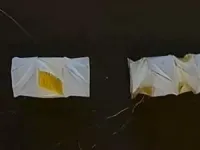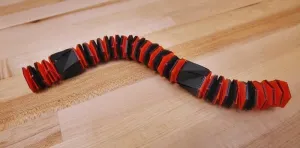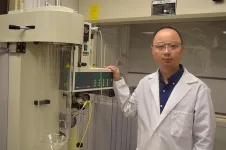(Press-News.org) MIAMI, FLORIDA (EMBARGOED UNTIL MAY 6, 2024 AT 3:00 P.M. EDT) – Researchers at Sylvester Comprehensive Cancer Center at the University of Miami Miller School of Medicine have developed a nanoparticle that can penetrate the blood-brain barrier. Their goal is to kill primary breast cancer tumors and brain metastases in one treatment, and their research shows the method can shrink breast and brain tumors in laboratory studies.
Brain metastases, as these secondary tumors are called, most commonly arise from solid tumors like breast, lung and colon cancer and are often associated with a poor prognosis. When cancer breaches the brain, it can be difficult for treatment to follow, in part because of the blood-brain barrier, a near-impenetrable membrane that separates the brain from the rest of the body.
The Sylvester team’s nanoparticle may one day be used to treat the metastases with the added benefit of treating the primary tumor at the same time, according to Shanta Dhar, Ph.D., an associate professor of Biochemistry and Molecular Biology and assistant director of Technology and Innovation at Sylvester, who led the study. She is the senior author of a paper published May 6 in the journal Proceedings of the National Academy of Sciences.
By loading the particle with two prodrugs that target mitochondria, the energy production center of the cell, the researchers showed that their method could shrink breast and brain tumors in preclinical studies.
“I always say nanomedicine is the future, but of course we have already been in that future,” said Dhar, referring to commercially available COVID-19 vaccines, which use nanoparticles in their formulation. “Nanomedicine is definitely also the future for cancer therapeutics.”
The new method uses a nanoparticle made of a biodegradable polymer, previously developed by Dhar’s team, coupled with two drugs also developed in her lab that take aim at cancer’s energy sources. Because cancer cells often have a different form of metabolism than healthy cells, stifling their metabolism can be an effective way to kill tumors without harming other tissues.
One of these drugs is a modified version of a classic chemotherapy drug, cisplatin, which kills cancer cells by damaging DNA in rapidly growing cells, effectively halting their growth. But tumor cells can repair their DNA, sometimes leading to cisplatin resistance. Dhar’s team modified the drug to shift its target from nuclear DNA, the DNA that makes up our chromosomes and genome, to mitochondrial DNA. Mitochondria are our cells’ energy sources and contain their own, much smaller genomes — and, importantly for cancer therapeutic purposes, they don’t have the same DNA-repair machinery that our larger genomes do.
Because cancer cells can switch between different energy sources to sustain their growth and proliferation, the researchers combined their modified cisplatin, which they call Platin-M and attacks the energy-generating process known as oxidative phosphorylation, with another drug they developed, Mito-DCA, that specifically targets a mitochondrial protein known as a kinase and inhibits glycolysis, a different kind of energy generation.
Dhar said it was a long route to develop a nanoparticle that can access the brain. She has been working on nanoparticles for her whole independent career, and in a previous project studying different forms of polymers, the researchers noticed that a small fraction of some of these nanoparticles reached the brain in preclinical studies. By honing those polymers further, Dhar’s team developed a nanoparticle that can cross both the blood-brain barrier and the outer membrane of mitochondria.
“There have been a lot of ups and downs to figuring this out, and we’re still working to understand the mechanism by which these particles cross the blood-brain barrier,” Dhar said.
The team then tested the specialized drug-loaded nanoparticle in preclinical studies and found that they work to shrink both breast tumors and breast cancer cells that were seeded in the brain to form tumors there. The nanoparticle-drug combination also appeared to be nontoxic and significantly extended survival in lab studies.
Next, the team wants to test their method in the lab to replicate human brain metastases more closely, perhaps even using patient-derived cancer cells. They also want to test the drug in laboratory models of glioblastoma, a particularly aggressive brain cancer.
“I’m really interested in polymer chemistry, and using that toward medical purposes really fascinates me,” said Akash Ashokan, a University of Miami doctoral student working in Dhar’s lab and co-first author on the study along with doctoral student Shrita Sarkar. “It’s great to see that applied toward cancer therapeutics.”
about this important research on the InventUM Blog and follow @SylvesterCancer on X for the latest news on its research and care.
Authors: A complete listing of authors is available in the paper.
Funding: S.D. acknowledges the financial support from Sylvester Comprehensive Cancer Center, the NCI funded Sylvester Comprehensive Cancer Center support grant 1P30CA240139, Bankhead Coley Cancer Research grant (8BC10), and Sylvester bridge funding award.
Disclosures/potential conflicts: The authors declare no competing interests.
Article Title: PNAS: Simultaneous targeting of peripheral and brain tumors with a therapeutic nanoparticle to disrupt metabolic adaptability at both sites.
DOI: https://doi.org/10.1073/pnas.2318119121
# # #
EMBARGOED UNTIL MAY 6, 2024 AT 3:00 P.M. EDT
END
Engineers at Princeton and North Carolina State University have combined ancient paperfolding and modern materials science to create a soft robot that bends and twists through mazes with ease.
Soft robots can be challenging to guide because steering equipment often increases the robot’s rigidity and cuts its flexibility. The new design overcomes those problems by building the steering system directly into the robot’s body, said Tuo Zhao, a postdoctoral researcher at Princeton.
In an article published May 6 in the journal PNAS, the researchers describe how they created the robot out ...
Scientists at the University of Colorado Boulder and Princeton University have, for the first time, employed a tool often used in geology to detect the atomic fingerprints of cancer.
In a case of medicine meets earth science, the researchers discovered that cancer cells may be made from a different assortment of hydrogen atoms than healthy tissue. The findings could give doctors new strategies for studying how cancer grows and spreads—and may even, one day, lead to new ways to spot cancer early on in the body.
The team, led by CU Boulder geochemist Ashley Maloney, will publish its findings this week ...
WEST LAFAYETTE, Ind. — Qi “Tony” Zhou, a researcher in Purdue University’s College of Pharmacy has received a $2.4 million grant from the National Institutes of Health to fight lung infections that have established a resistance to antimicrobial drugs.
Zhou is an associate professor in the Department of Industrial and Molecular Pharmaceutics, a Faculty Scholar and a faculty member of the Purdue Institute for Drug Discovery and the Purdue Institute of Inflammation, Immunology and Infectious Disease. He leads a team of multinational experts from Australia, Thailand and the United States in developing novel, patent-pending ...
Researchers at the University of Pittsburgh and Drexel University in Philadelphia, along with Brookhaven National Laboratory, are working to solve a multipart mystery to make water disinfection treatments more sustainable.
Scalable electrochemical ozone production (EOP) technologies to disinfect dirty water may someday replace centralized chlorine treatments used today, whether in modern cities or remote villages. However, little is understood about EOP at the molecular level and how technologies that make it possible can be made to be efficient, economical, and sustainable.
Their research, “Interplay between Catalyst Corrosion and Homogeneous Reactive Oxygen Species ...
Images
The U.S. Office of Naval Research is tapping academic expertise at the University of Michigan to solve current and future problems, Secretary of the Navy Carlos Del Toro announced during his visit to campus over graduation weekend.
The $14.5M Center for Naval Research and Education will also help train an engineering research community familiar with naval and marine applications.
"I am incredibly proud of the partnership between the University of Michigan and the Department of the Navy. Michigan is a key teammate in rebuilding our shipbuilding industry and restoring the comprehensive—commercial ...
PHILADELPHIA (May 6, 2024) – Penn Nursing is proud to launch a groundbreaking new online course – Educating Nurses in Psychedelic Assisted Therapy – via Open Canvas. This free comprehensive course is designed to prepare nursing professionals for the pioneering field of psychedelic assisted therapy (PAT), aligning with the latest advancements in mental health treatment and Penn Nursing's commitment to social justice in healthcare.
With this new modality of care on the horizon, the need for well-educated, ...
Michele Greet, Director, Art History Program, received funding for: “Abstraction in the Andes, 1950-1970.”
She will examine the emergence of abstract painting in Andean countries (Peru, Ecuador, and Bolivia) in the 1950s and 1960s. She will explore artists’ newfound interest in pre-Columbian art as source material as well as the circulation of ideas from Europe and the United States.
Although abstract art rapidly gained acceptance throughout Latin America after World War II, until recently, studies of abstract painting in the region have focused on the geometric styles that emerged in Brazil, Argentina, and Venezuela. Different variants of abstraction ...
Supplementing standard opioid addiction treatment with Mindfulness Oriented Recovery Enhancement (MORE) — an intervention that incorporates mindfulness training, savoring skills, and cognitive reappraisal — cuts program dropout rates by 59 percent and relapses by 42 percent, according to Rutgers-led research.
These trial results come from Rutgers Health amid unprecedented opioid abuse. An estimated 10 million Americans misuse opioids or have opioid use disorder, while annual overdose deaths have exceeded 80,000.
Treatment with methadone or buprenorphine – alone or in combination with cognitive behavioral therapy – is imperfect. Half ...
In research that may be a step forward toward finding personalized treatments for Tourette disorder, scientists at Rutgers University–New Brunswick have bred mice that exhibit some of the same behaviors and brain abnormalities seen in humans with the disorder.
As reported in the Proceedings of the National Academy of Sciences, the researchers, using a technique known as CRISPR/Cas9 DNA editing that selectively modifies the DNA of living organisms, inserted the same genetic mutations found in humans with Tourette disorder into the corresponding genes in mouse embryos. After the mice were born, the scientists observed their behavior compared with littermates without the ...
ITHACA, N.Y. -- Collaborating on a physical object when two people aren’t in the same room can be extremely challenging, but a new remote conferencing system allows the remote user to manipulate a view of the scene in 3D, to assist in complex tasks like debugging complicated hardware.
The system, called SharedNeRF, combines two graphics rendering techniques – one that is slow and photorealistic, and another that is instantaneous but less precise – to help the remote user experience ...




